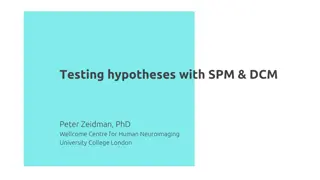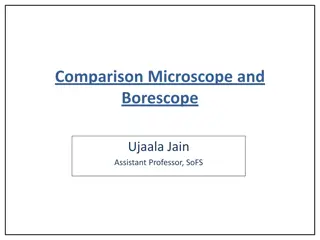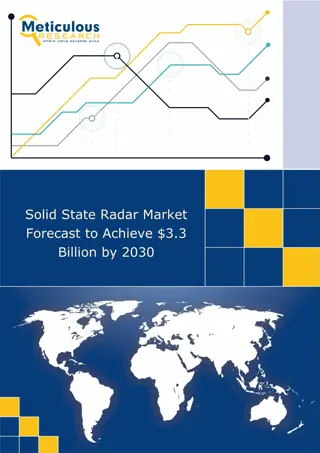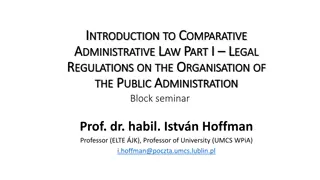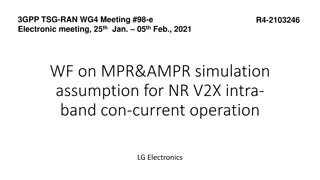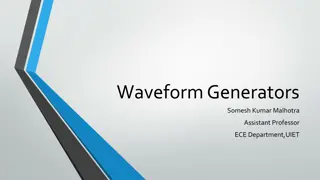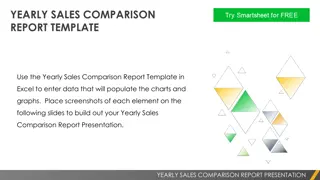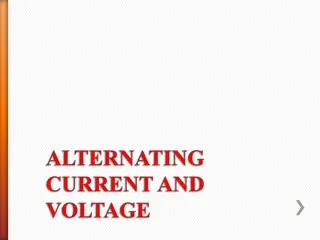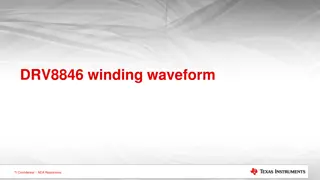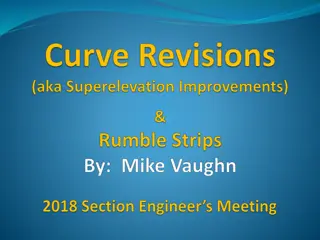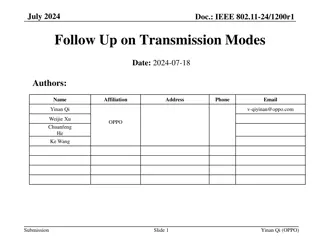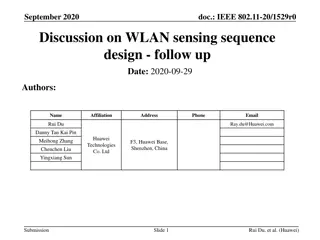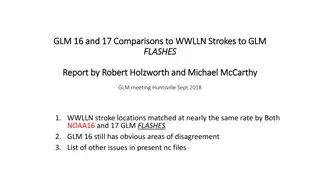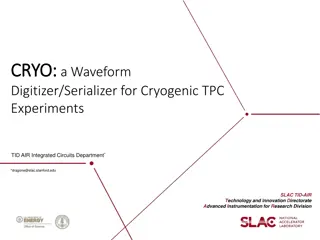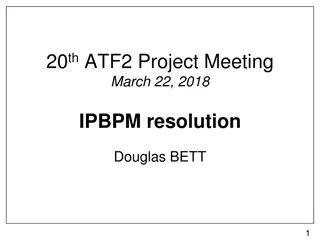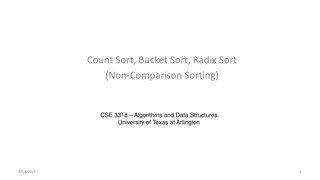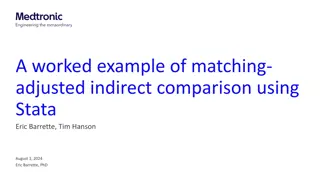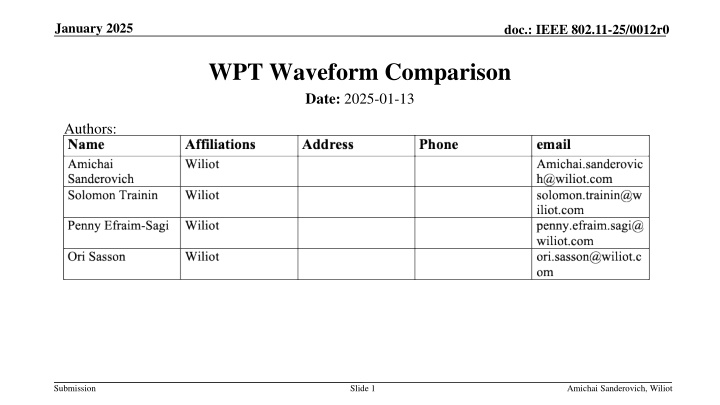
WPT Waveform Comparison for Enhanced RF Harvesting Efficiency
Explore the comparison of Wireless Power Transfer (WPT) waveforms, including OFDM and Pulse Position Modulation, for optimizing RF harvesting efficiency in IEEE 802.11 standards. Considerations for RF harvesting efficiency, regulatory impacts, transmitter efficiency, and potential interference are discussed. Understand the trade-offs in optimizing for energy collection efficiency and output power. Discover key factors affecting RF harvester optimization and waveform selection for maximizing harvested energy.
Download Presentation

Please find below an Image/Link to download the presentation.
The content on the website is provided AS IS for your information and personal use only. It may not be sold, licensed, or shared on other websites without obtaining consent from the author. If you encounter any issues during the download, it is possible that the publisher has removed the file from their server.
You are allowed to download the files provided on this website for personal or commercial use, subject to the condition that they are used lawfully. All files are the property of their respective owners.
The content on the website is provided AS IS for your information and personal use only. It may not be sold, licensed, or shared on other websites without obtaining consent from the author.
E N D
Presentation Transcript
January 2025 doc.: IEEE 802.11-25/0012r0 WPT Waveform Comparison Date: 2025-01-13 Authors: Submission Slide 1 Amichai Sanderovich, Wiliot
January 2025 doc.: IEEE 802.11-25/0012r0 Abstract In previous contributions [1], a WPT (Wireless Power Transfer) comparison was made between OFDM and single carrier waveforms for the sake of getting the best RF harvesting efficiency for a given output EIRP. In this contribution we add to [1] with an analysis of implemented harvester and also with a PPM (Pulse Position Modulation) waveform. Submission Slide 2 Amichai Sanderovich, Wiliot
January 2025 doc.: IEEE 802.11-25/0012r0 WPT Considerations In Terms of RF Harvesting Efficiency Other important considerations that were not covered in this contribution: 1. Impact of regulations on EIRP and duty cycle in S1G and 2.4 ISM bands There are multiple regulatory limitations depending on geographic location that change the preferences, range, channels, etc. of the possible WPT waveforms 802.11bp should consider. 2. Impact of transmitter efficiency Since all the system energy is eventually coming out of the WPT transmitter, it is of importance that it can operate in an efficient way so to save electricity bill or battery life. 3. Impact of transmitter implementation complexity (incl. thermal issues) There are TX power levels that require higher complexity transmitters compared to lower levels. For example, transmitter with 30dBm transmit power is much more complex compared to one with 10dBm. 4. Impact of interference to communication in nearby or same band There may be waveforms that are more prone to cause interference to neighbouring channels/bands or within the same channel. Submission Slide 3 Amichai Sanderovich, Wiliot
January 2025 doc.: IEEE 802.11-25/0012r0 RF Harvesting Efficiency Most RF harvesters are optimized to certain input power level. As the input power level is different the resulting efficiency will be reduced For example, a harvester optimized for energy collection efficiency over some arbitrary input power can look like this: Notice that even though efficiency is not monotonic in Pin, the collected power is still monotonic Trade-off: optimizing for long range (sensitivity) the shorter range is slower relative to the power increase Design consideration: optimizing for maximum harvested and stored energy vs. maximum output power [most academic reports] Submission Slide 4 Amichai Sanderovich, Wiliot
January 2025 doc.: IEEE 802.11-25/0012r0 Considered WPT Waveform for Comparison OFDM (high PAPR): Very common in multiple communication standards, e.g. 802.11ax, 5G-NR, Provides very good protection for frequency selective channels Transmitters usually operate at 20-25% efficiency Keeping low out of band emissions require more complex devices, especially for higher power Constant Envelope (low PAPR): Very common in multiple communication standards, e.g. 802.11b, LTE, Transmitters usually operate at >50% efficiency PPM (Pulse Position Modulation, very high PAPR): Several communication standards, e.g. UWB (802.15.4) Lower interference impact due to lower duty cycles Transmitters usually operate at >50% efficiency Transmit in high power requires higher power PAs or higher duty cycles Submission Slide 5 Amichai Sanderovich, Wiliot
January 2025 doc.: IEEE 802.11-25/0012r0 WPT Waveform Comparison We compared the wavefroms using the same average input power: metric is time to first packet (TTFP) Assumptions made for: Pin, triggering frequency (50ms) and wakeup, receive and transmit energies For device sensitivity point, PPM provides almost x10 improvement over OFDM/CE in terms of TTFP We did not observe OFDM advantage PPM duty cycle of 50%,10%,5%,1% means PAPR of PPM TX of 3dB/10dB/13dB/20dB resp PPM provides flexibility to reach each efficiency point within every Pin [under HW and regulation limits] Submission Slide 6 Amichai Sanderovich, Wiliot
January 2025 doc.: IEEE 802.11-25/0012r0 Summary We presented RF harvesting efficiency over an examplary harvester Main challenge is collecting enough energy from lower input power We noticed that PPM modulation provided ~x10 advantage over OFDM or CE when comparing the same average power at the device sensitivity point. We notice that PPM can be transmitted using efficient transmitters. For very short cycles of few us, the impact of PPM to existing OFDM/MSK/CSS devices in S1G is very limited Amendment recommends specific 1-2 S1G channels for energizing advantage More work is needed to encompass regulatory status, tx complexity and efficiency, frequency selective channels and also interference to other devices. An Submission Slide 7 Amichai Sanderovich, Wiliot
January 2025 doc.: IEEE 802.11-25/0012r0 References [1] 11-24-1808-00-00bp-ofdm-based-wpt-waveform, Panpan Li (Huawei) Submission Slide 8 Amichai Sanderovich, Wiliot

